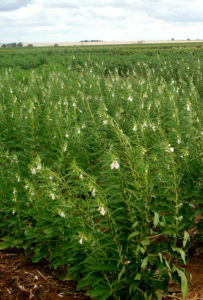More than just cotton
Conservation cropping systems, crop rotation focus of Rolling Plains study
Writer: Kay Ledbetter, 806-677-5608, [email protected]
Contact: Dr. Curtis Adams, 940-552-9941, [email protected]
Dr. Paul DeLaune, 940-552-9941, [email protected]
VERNON – Conservation practices are a growing part of cropping systems in the Rolling Plains, according to Texas A&M AgriLife Research scientists who are helping producers look at the big picture, instead of just crop to crop.

Dr. Curtis Adams, cropping systems agronomist, and Dr. Paul DeLaune, environmental soil scientist, both with AgriLife Research in Vernon, are working jointly to research where conservation practices can be incorporated into crop production.
Adams said use of conservation practices is expanding as research demonstrates the advantages they offer in a time producers are seeking solutions to issues they face in making their farming operations viable and profitable.
“We are seeing cropping systems based on conservation management practices becoming more widespread,” he said.
Some examples of conservation practices include crop rotation, reduced or no tillage, and filling fallow periods with cover crops.
DeLaune has completed eight years of research on tillage and cover cropping. His prior findings are being incorporated into the cropping system research, using approaches shown to work in this environment.
“After eight years, we know no-till alone doesn’t make a big difference, nor does a cover crop alone,” DeLaune said. “But we know combining these practices with crop rotation can, and this work will be important in expanding the use of these practices.”

Adams said crop rotation is one area that has been understudied in cotton systems in this region and is often neglected by producers.
“When cotton brings a relatively high price, it can be tempting for producers to put most of their acreage in that crop year after year,” he said.
But this practice has drawbacks on a long-term basis, and also possibly in the short term, Adams said.
“In communicating with producers, I frequently hear concerns about the negative impacts of price fluctuations from their primary crop, especially low price swings,” he said. “Diversifying your portfolio with crop rotation is one of the best ways to deal with this problem, and there are other benefits too.”
At the AgriLife Research station south of Chillicothe, Adams and DeLaune initiated a systems research study focusing on crop rotation in conservation cotton cropping systems.
“We are comparing three dryland cotton systems that differ in rotation crop to a system with no rotation,” Adams said.
The crops to be rotated with cotton are sesame, guar and sorghum, he said. Each of these crops is well adapted to dryland growing conditions in the Rolling Plains and have established markets.
Adams said each of the cropping systems, including the continuous cotton system, have no tillage and off-season cover crops.

“Including these conservation practices in every system is meant to build on the advancements of previous research,” he said. “For comparison, a completely conventional system that has continuous cotton, a fallow winter and tillage is also included in the study.”
Adams said plots representing both sequences of each crop rotation are included in the study to provide an understanding on how each crop is affected by environmental conditions in each cropping system in any given year.
“For example, there are plots for the sesame-cotton sequence and for cotton-sesame,” he said.
Some of the measurements Adams and DeLaune will take include crop productivity, quality, year-round soil moisture, soil carbon and fertility.
The initial cover crop used was wheat, but Adams said they intend to introduce legumes and other cover crops that will help make the soil healthier, based on DeLaune’s research.
Additionally, they intend to look at the economics of running each system to see how different crops and other management factors affect the bottom line.
“This is critical information for producers,” Adams said.
DeLaune said because mono-cropping systems are predominant in the region, this research is important to show producers benefits of crop rotation and to provide suitable options to enhance agronomic and economic viability.
This is only the second year of this study, and Adams said it will take several years to get a lot of meaningful data.
“But in the coming years, the study will be a resource for Rolling Plains producers to see how crop rotation and other conservation management practices come together in a cropping system and to see the effects of using them,” he said.
Adams said he anticipates the rotational systems will have several benefits over the continuous cotton systems.
“I expect soil water infiltration and storage capacity will improve and there will be improvements in soil nitrogen fertility, particularly in the cotton-guar system. There may also be increases in soil carbon over time.”
He also expects to see improvements in yields in response to these positive system changes.
But Adams said in the long run, the most practical benefit of the rotational systems will likely be simple diversification of the product being produced.
“When producers have much of their acreage in a single crop, they are subject to every up and down in the market, diseases going around that target their crop, and weather factors that may have crop-specific negative impacts,” he said. “But if they are diversified, they would have some protection against these issues. It pays to have multiple crops out there with different susceptibilities and resilience to things that can impact them.”
Adams said while it will take several more years to draw strong conclusions from the study, producers will be able to monitor the trial year-to-year at field days.


